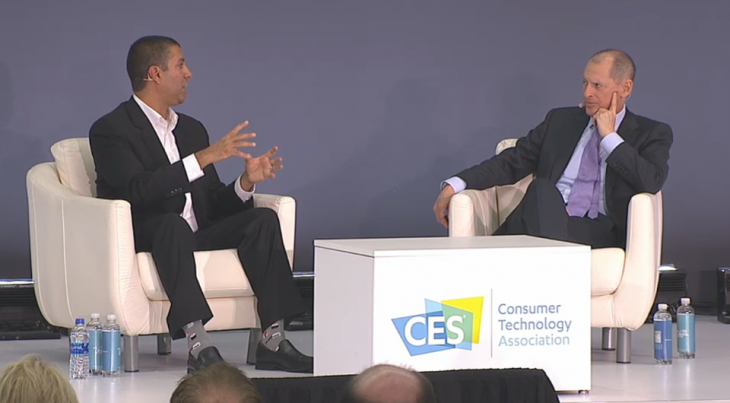
By John Bugailiskis
LAS VEGAS – In his first appearance at CES since he became chairman of the Federal Communications Commission in 2017, Ajit Pai sat down with Consumer Technology Association president and CEO Gary Shapiro last week for a Fireside Chat (30:40 mark) to discuss the “rapidly changing technology landscape.” Topics discussed ranged from privacy, the opportunities of 5G and net neutrality.
In 2018, Pai had to cancel a planned visit to CES due to death threats over his decision to repeal net neutrality rules implemented by the previous administration. Those rules were put in place to stop internet service providers from manipulating network traffic for discriminatory purposes. Last year Pai cancelled his scheduled appearance due to the government shutdown.
Regarding net neutrality, Pai told CES attendees “Since we made our decision in December 2017, speeds are up for fixed broadband, over 60 % according to Ookla, broadband infrastructure investment is up, more Americans are getting connected to the internet than ever before. More fibre was laid in 2019 to homes and business in the United States than in any year since they have been keeping records.”
While broadband speeds have increased over the last few years, for a variety of reasons, there’s no evidence indicating Pai’s repeal of net neutrality had a direct impact.
In fact, a recent study from George Washington University found that Pai’s claims at CES about the impact of repealing net neutrality are not accurate. The study closely examined the earnings reports and SEC filings of 8,577 companies (including hundreds of telcos) from Q1 2009 through Q3 2018. It concluded that the passage and repeal of the rules had “no impacts on telecommunication industry investment from the net neutrality policy changes.”
Which may well mean that both the initial rules – and then the repeal – had little effect on broadband rollouts in the U.S.
On the spectrum front, Pai said he is confident that the FCC will be able to remove constraints on unlicensed spectrum this year. The FCC has made auctioning high-band spectrum a priority. A 5G spectrum auction currently underway in the upper 37 GHz, 39 GHz, and 47 GHz bands has already surpassed $6 billion in total bids. The spectrum can be used for both fixed and mobile broadband and is being auctioned in 100 MHz blocks. He noted T-Mobile is already covering about 200 million people with its 5G network (to which almost no one is connected because there are precious few devices in the market), but that other carriers are not far behind.
“Our top mission at the FCC, and regardless of any band, is to ensure those public resources are being deployed for the benefit of the American people,” Pai told CES attendees. He conceded that achieving that mission is “increasingly difficult” because “every single band we’re talking about has incumbents, and so we’ve got to think very creatively about sharing models.”
Pai has also been criticized on plans to free up spectrum in the C-band, 5.9 GHz or Dedicated Short Range Communication (DSRC) and 6 GHz bands, by sharing it with incumbent users. Telecoms have been lobbying for exclusive use of the DSRC spectrum for the past few years. Additionally, the cable industry wants to access the reserved frequencies for home Wi-Fi use, enabling Gigabit speeds by using 160-MHz-wide channels.
The FCC chairman also promoted his 5G Fast Plan on stage, which focuses on more spectrum into the marketplace, updating infrastructure policy, and modernizing outdated regulations.
Pai told the CES attendees he was confident 5G wireless could help close the rural “digital divide” but conceded challenges existed to building out the next-generation technology where it is needed. “5G is something we’re very excited about. We’re getting more spectrum into the marketplace and promoting more fiber deployment. We’re aggressively executing on each of those.”
Pai also said significant barriers still stand in the way of rolling out 5G. “It’s not cheap to build a 5G network, and the scale of the network that you have to build is pretty massive if you want to create a nationwide network.”
A few days later, on January 10, Pai addressed the Hawaii International Conference on Science Systems in Maui, Hawaii and updated them that the FCC is working to establish a Rural Digital Opportunity Fund. The fund would provide up to US$20.4 billion over the next decade to support the deployment of high-speed broadband networks in those parts of rural America that currently lack fixed broadband service that meets the Commission’s baseline speed standards.
“Based on our initial estimates, which I must caution are subject to change, approximately six million homes and small businesses in the United States are located in areas that would be eligible for the auction’s first phase.”



